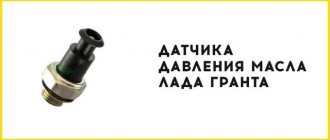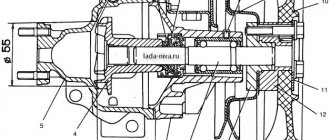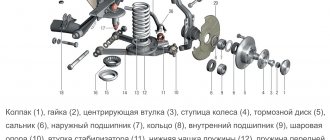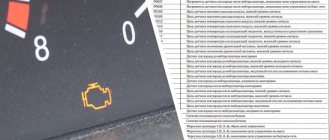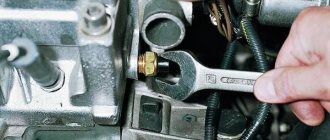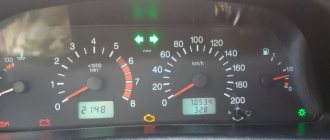Car problems are unpleasant for every driver. If a metallic clanging occurs in the engine (we are talking about a Chevrolet Niva car), first of all pay attention to the knock sensor. Most often, its breakdown causes power unit failures.
You will learn from the article how to replace the knock sensor on a Niva Chevrolet, its functions, location, signs of inoperability, causes of failure, and testing methods. The information will help you make the right decision during an emergency.
Problems with engine detonation on a Chevrolet Niva car
The problem of detonation is also familiar to the Chevrolet Niva. Coming from an SUV family, the Niva has the peculiarity of frequent trips not only off-road, but also in hills and mountainous areas. Therefore, when climbing at low speed and in high gear, you sometimes hear the sound of a metallic clatter. This phenomenon can lead to the following types of problems:
- Engine failure resulting from the action of a destructive force on the cylinder head and crank mechanism;
- Burnout of the cylinder head gasket (cylinder head), which occurs when the temperature rises to critical values during detonation. Often the first one to become unusable and requires immediate replacement;
- Piston burnout. Corrosion of the piston crown appears and with frequent exposure to this phenomenon, it leads to burnout.
Therefore, it is necessary to control the operation of the engine when moving up at low speeds and in high gear. Detonation can contribute to the failure of the cylinder block, pistons and crankshaft of a Chevrolet Niva, which can only be corrected by replacing them with new ones, which will be practically very expensive.
The true reasons for the occurrence of this phenomenon on the Chevrolet Niva
All cars are susceptible to this phenomenon. The main reasons that lead to this effect are:
- Circumstances under which the Chevrolet Niva is operated. This is exactly the case when climbing a steep hill at a speed below 40 km/h and in fourth gear;
- Quality of the fuel mixture. If the octane number is low, then detonation is guaranteed. A high number ensures detonation resistance;
- Design characteristics of the motor. These include: the condition of the spark plugs and their location, the shape of the combustion chamber, the compression ratio and the shape of the piston.
What methods of protection are provided in Shnivy against detonation?
Chevrolet Niva is equipped with a knock sensor. It is designed to protect the motor from this effect, as well as to display the process of its occurrence in the form of a light alarm. The sensor is a sensitive element made of piezoceramic material. On the Chevrolet Niva it is located in the area of the cylinder block. The operating principle of the sensor is as follows:
- When the phenomenon of engine detonation appears, the amplitude of its vibrations increases;
- The built-in controller on the instrument panel corrects the ignition timing, which helps to dampen the phenomenon;
- The signal to the controller is supplied by a sensor, which generates an incoming voltage signal that occurs under certain engine vibration parameters;
- The controller is also capable of displaying a sensor malfunction in the form of a light alarm on the instrument panel. The alarm is represented by the inscription “CHEK ENGINE”, familiar to all drivers, which is highlighted in red.
This is interesting: Tuning Lifan Solano with your own hands: interior, chip tuning
Niva Chevrolet knock sensor
Knock sensor (DS) of the Chevrolet Niva engine (controller M7.9.7)
The knock sensor (DS) (Fig. 1.1-09) is installed on the cylinder block (Fig. 1.1-10). The piezoceramic sensing element of the DD generates an alternating current voltage signal, the amplitude and frequency of which correspond to the engine vibration parameters.
When detonation occurs, the amplitude of vibrations of a certain frequency increases. At the same time, the controller adjusts the ignition timing to dampen detonation.
If a malfunction occurs in the DD circuits, the controller stores its code in its memory and turns on the alarm. To identify and eliminate the fault, you must use the appropriate diagnostic card.
Removing the knock sensor
1. Turn off the ignition
2. Disconnect the wires from the sensor.
3. Unscrew the mounting bolt and remove the sensor.
Installing a knock sensor
1. Install the sensor by tightening the bolt to a torque of 10.4. 24.2 N • m.
2. Connect the wiring harness block to the sensor.
Oxygen sensor (OS) of the Chevrolet Niva engine (controller M7.9.7)
The most effective reduction in the toxicity of exhaust gases from gasoline engines is achieved with a mass ratio of air and fuel in the mixture (14.5. 14.6): 1. This ratio is called stoichiometric. With this composition of the air-fuel mixture, the catalytic converter most effectively reduces the amount of hydrocarbons, carbon monoxide and nitrogen oxides emitted in the exhaust gases. To optimize the composition of the exhaust gases in order to achieve the greatest efficiency of the converter, closed-loop fuel supply control is used with feedback on the presence of oxygen in the exhaust gases.
The controller calculates the injection pulse duration based on parameters such as air mass flow, crankshaft speed, coolant temperature, etc. To adjust the calculations of the duration of the injection pulse, information about the presence of oxygen in the exhaust gases is used, which is provided by the oxygen sensor (OS) (Fig. 1.1-11).
The DC is installed in the exhaust system pipe (Fig. 1.1-12). Its sensitive element is located in the exhaust gas flow. The DC generates a voltage varying in the range of 50...900mV. This output voltage depends on the presence or absence of oxygen in the exhaust gases and on the temperature of the DC sensitive element.
When the DC is in a cold state, there is no output signal from the sensor, since in this state its internal electrical resistance is very high - several megohms. As the sensor warms up, the resistance drops and the ability to generate an output signal becomes possible.
To operate effectively, the DC must have a temperature of at least 300°C. For quick warm-up after starting the engine, the DC is equipped with an internal electric heating element, which is controlled by a controller. The duty cycle of heater control pulse signals (the ratio of the duration of the on state to the pulse repetition period) depends on the temperature of the DC and the operating mode of the engine.
If the sensor temperature is above 300°C, then at the moment of passing through the stoichiometry point, the sensor output signal switches between low level (50.200 mV) and high level (700.900 mV). A low signal level corresponds to a lean mixture (presence of oxygen), a high signal level corresponds to a rich mixture (no oxygen).
Description of the circuit operation
The controller supplies a stable reference voltage of 450 mV to the DC circuit. When the DC is not warmed up, the voltage of the sensor output signal is in the range of 300.600 mV. As the sensor warms up, its internal resistance decreases and it begins to generate varying voltages outside this range. By changing the voltage, the controller determines that the DC has warmed up, and its output signal can be used to control the fuel supply in closed loop mode.
Typical breakdowns
Be sure to listen to how the engine operates as the load increases - if even the slightest metallic clatter appears, be sure to make a diagnosis.
Otherwise, you may experience the following problems:
- Burnout of the gasket under the cylinder head. When detonation occurs, the engine temperature increases.
- Destruction of the pistons, as they all corrode.
- Very often, elements of the crank mechanism and cylinder head are destroyed.
If you are driving your car up a hill and the gear is in high gear, be sure to monitor the engine. If you subject the engine to heavy loads, you will contribute to the appearance of detonation knocks. As a result, many elements of the car will fail, and this is the first step towards a major overhaul.
What are the main elements it consists of?
The detonation controller is a complex assembly containing the following elements:
- connector where the power cable is connected;
- threaded connection to the block;
- sensitive element.
The sensor is made in a closed housing and cannot be repaired if it breaks. If there are any problems, the entire part should be replaced.
Where is the knock sensor of the Niva Chevrolet located?
The standard Chevrolet Niva knock sensor is designed to determine the moment of improper ignition of the fuel mixture in the engine. To put it simply, on the Shnivy, the sensor tells the ECU when the mixture is not ignited in a timely manner in the cylinders, which significantly affects the stability of the engine during active operation.
On a VAZ 2131 with an injector, the part is permanently mounted. Carburetor modifications do not have the element.
Sensor operation
The functioning of the sensor is based on measuring the vibrations and noise emitted by the engine during its operation. A special membrane is installed inside the part to capture vibrations. Next, the signal is sent to the ECU, where it is processed and the electronics calibrate the ignition.
What are the main elements it consists of?
- connector where the power cable is connected;
- threaded connection to the block;
- sensitive element.
The sensor is made in a closed housing and cannot be repaired if it breaks. If there are any problems, the entire part should be replaced.
Connection diagram for the knock sensor Shnivy
Carried out directly to the ECU. The piezoelectric element has only two terminals that are connected independently. Any motorist can connect the sensor.
Location
On a VAZ 21214 with a carburetor engine, the part is missing as it is unnecessary.
How does detonation occur?
The process does not form on its own. For a negative effect to occur, the combustion chamber will need to be very hot. Under the influence of high temperatures, the ignition timing shifts and improper ignition occurs.
What methods of protection are provided in Shnivy against detonation?
The only protection against the harmful process is DDTS. The simplest and most reliable device. When a part transmits a fault signal, the BC processes it and adjusts the ignition timing.
This is how protection occurs - a spark is formed on time and everything burns evenly.
Symptoms of a problem
Typical signs of failure are:
- increased fuel consumption;
- formation of characteristic noise while driving;
- The signal level coming from the device is too high or low.
Knock Sensor Errors
- Damage to wiring. The sensor wires are located in close proximity to the motor. Periodically, the braid wears out, which leads to loss of impulse or short circuit.
- Worn or oxidized pads. The sensor connectors may become corroded. A simple cleaning of the terminals with a naphtha or sandpaper will help here. It also wouldn't hurt to additionally crimp the joints.
- Damage to the sensor itself. Everything is simple here - the damaged part is replaced with a new one.
- Program system error. In this case, you will need the help of a qualified technician.
Sensor check
To check with a multimeter, just follow a simple procedure.
- Remove the sensor from the engine.
- Set the tester to DC voltage meter mode.
- Connect the terminals of the devices in the standard sequence.
- Tap the sensor body with moderate force with a screwdriver or other object.
- During the master’s manipulations, the readings on the device should change (the device is working). If the signal is static, the part is damaged and requires replacement.
What to do in case of malfunctions
Due to the fact that the on-board wiring on the car suffers from low reliability. The DD check must be performed in stages. In the event of a malfunction, you should walk along the entire line, including the sensor, and visually assess its condition. If individual sections of the chain have apparently lost their integrity, they are replaced.
If replacing the wiring does not help, you need to dismantle and check the sensor.
Removing the sensor
Dismantling the device is quite simple. This does not require special tools or deep knowledge of mechanics. The part has one contact group and is attached to the engine block using a bolt with a No. 10 head. To remove it, you need to disconnect the wires and unscrew the fixing screw.
DIY replacement
To install another DD with and without air conditioning, an identical procedure should be followed.
- Place the machine on a level surface.
- Remove the terminals from the battery.
- Allowing the machine to cool down will make the work more comfortable.
- Disconnect the power terminal from the sensor. If the group is worn out or heavily oxidized, it is better to change it along with the sensor.
- Unscrew the fastening bolt and use a screwdriver to remove the damaged part.
- Place a new DD in the seat and reassemble the chain in the reverse order.
Verification methods
It is easy to check the inoperability of the DD yourself without dismantling it by conducting preliminary testing.
How to do it:
- put the engine at idle speed (about 2000 rpm);
- lightly tap with a hammer near the sensor.
A drop in engine speed (which will be audible) will indicate the serviceability of the part . If the speed remains unchanged, then the piezoelectric element is tested additionally. To do this, the DD will need to be removed by unscrewing the mounting bolt and disconnecting the block.
Then use a voltmeter or multimeter .
The procedure is as follows:
- connect the tester to the DD contacts;
- set constant voltage mode;
- Using light taps on the sensor, monitor the meter readings.
Voltage fluctuations of up to 0.2 volts are a sign of the operating condition of the DD . If there are no voltage surges, it means it is damaged and must be replaced.
This is interesting: Timing chain ZMZ-405: do-it-yourself replacement
Where is it located?
Many people wonder where to find this knock sensor?! The location of the knock sensor is in the engine compartment of the Niva, namely on the cylinder block near the oil filter.
The location of the sensor is determined by the fact that this is the most sensitive area for detecting various engine detonations. This helps to quickly localize the problem in order to avoid engine breakdowns.
Price and article
Below is a table with prices for knock sensors for Niva from manufacturers that have proven themselves well in the market.
| Manufacturer | vendor code | Price, (rubles) |
| LADA (original) | 21123855020 | 200-400 |
| "Road map" | 21123855020 | 250-360 |
| Fenox | SD10100O7 | 200-400 |
| ERA | 550489 | 300-400 |
| Decaro | 2112-3855020 | 380-500 |
Sensor cost
The knock sensor has extremely low maintainability. Usually, when it fails, it requires replacement with a new DD. The original General Motors sensor has part number 21120-3855020-02-0. Its price is 450-550 rubles. If there is a need to change the DD, then you can purchase an analogue. The table below presents the best alternative options for a branded product.
Table - Good analogues of the original Chevrolet Niva knock sensor
| Manufacturer | vendor code | Approximate cost, ruble |
| Bosch | 0 261 231 046 | 850-1000 |
| Fenox | SD10100O7 | 500-850 |
| Lada | 21120-3855020 | 190-250 |
| AvtoVAZ | 211203855020020 | 300-350 |
| EPS | 1.957.001 | 400-500 |
Is it possible to avoid detonation?
Pay attention to where the knock sensor is located on the Chevrolet Niva. It is located in the center of the engine block. The distance from the sensor installation location to the 1st and 4th cylinders is the same, thanks to this it allows you to capture all detonation knocks that appear in the internal combustion engine.
And in order to eliminate the possibility of detonation, it is enough to follow a few simple rules:
- When you drive your car uphill or off-road, you need to downshift. It is desirable that the engine operates at a frequency of 2500..3500 rpm.
- Monitor the condition of the spark plugs - the quality of ignition of the mixture depends on them. It is better to occasionally check the compression in each cylinder.
- It is not recommended to use gasoline with a low octane number. It is advisable to fill the tank only with fuel recommended by the car manufacturer.
What is a knock sensor and why is it needed?
This part is found in cars that use gasoline as fuel. It is intended for injection types of engines. The sensor is located on the engine cylinder block. This is an important part of the control system, the main purpose of which is to control the level of detonation.
There is a similar article on this topic -
In answering the question of what the knock sensor is responsible for , it should be noted that thanks to it the following vehicle capabilities are realized:
- Fuel economy.
- The ability of the engine to develop maximum power.
The sensor monitors the vehicle's starting system and regulates its proper operation.
What are the main components of a knock sensor?
The main details of this mechanism are:
- Vibrating plate.
- Piezo type electrical element.
- Signal wire.
- Braid.
Engine operating principle
Detonation very often occurs when going uphill. In this case, the car is moving slowly, and the speed is increased. But do not worry, since this phenomenon is called glow ignition, and it does not indicate that the engine is not working properly.
Any internal combustion engine works according to the following principles:
- A mixture of gasoline and air is supplied to the combustion chamber of the cylinders, where it is ignited by a spark on the spark plug. Moreover, the piston should be literally a few millimeters from top dead center. As soon as the piston reaches the top position, the greatest pressure is generated in the cylinder. At this moment, the entire air-fuel mixture will completely burn.
- During normal operation of the knock sensor on the Chevrolet Niva, signs of this phenomenon will not appear. This device will help get rid of the manifestation of detonation. And it appears when the mixture begins to ignite much earlier than it should. This usually happens halfway to top dead center. And when the air-fuel mixture burns, a force is exerted on the upper part of the piston, which pushes it in the opposite direction. At the same time, the engine power is reduced, and significantly, and its parts wear out.
How to check the knock sensor?
Unfortunately, the knock sensor can also fail. In this case, a person without special knowledge will be able to notice this only by the lit indicator. No other obvious signs will be noticed. The car will continue to operate in the same mode and start without any signs of breakdown.
At this point, it is necessary to remember that this device is not mechanical, it is part of an electronic system, and therefore the breakdown is considered electronic.
A knock sensor malfunction can happen for a number of different reasons, including:
- There has been a breakdown inside the sensor itself.
- Closure.
- The signal wire or braided shield is broken.
- Damage to the engine control unit.
Thus, it will not be difficult to identify the breakdown. In order to determine it, it is necessary to conduct a test.
But those who are not looking for easy ways can always carry out this simple process on their own. Self-checking occurs according to the following scheme:
- First, we remove the protection in the garage. You will have to work directly with the engine block.
- Now we rule out a break in the signal wire and shielding braid. If it is torn or the braid is torn, you need to check the fastening of the plug and socket of the sensor. The integrity of the braid must be checked.
- If a break is excluded, the outlet itself is assessed. It is possible that its connection is faulty and requires replacement.
- You can detect faults in the device itself using a voltmeter. In this case, the car must be started and idling.
- You also need to check the condition of the device contacts.
Also interesting: Rain sensor DDA15 for VAZ 2108-21099, 2113, 2114, 2115, 2110, 2111, 2112, Chevrolet Niva
You can check it yourself in a slightly different way. For this you need a multimeter. This device is very often found among car enthusiasts.
Checking the knock sensor with a multimeter is carried out only after it is removed from the engine. When checking, they knock on it with something metal. This method is the simplest.
We set the range to 200 mV, connect the positive and negative wires to the sensor terminal and to the metal ring, respectively. Do not confuse ground and signal pin! Now you need to hit it with something metal, but not too hard. The sensor will have to detonate.
You can check the sensor with another device called an oscilloscope. It will allow you to study the signal more qualitatively.
Now you need to tap the sensor lightly. The device will show detonation.
If the sensor detonates, then it is working, and the breakdown must be looked for elsewhere. But if the knock sensor signal is low or there is no signal, then this is a malfunction.
Causes of breakdowns
Failure of the pressure sensor circuit occurs for various reasons . Any of them can cause engine detonation. A thorough examination and diagnosis will help determine which one.
It could be:
- unsuitability of the piezoelectric element itself;
- outgoing cable break;
- sensor short to ground;
- lack of contact in the connector block;
- damage to the shielding braid.
Under no circumstances should you delay troubleshooting . The consequences of detonation can be very serious, namely, they will cause damage to the engine itself.
About the malfunction of the knock sensor
When the sensor fails, signs of a sensor malfunction are, first of all, the inclusion of a light indication on the “Check-engine” dashboard and detonating metallic knocks in the engine.
Instrument panel with illuminated “Check-engine” icon
Warning symptoms in vehicle operation: decreased engine power, increased fuel mixture consumption, and the appearance of smoky exhaust. The manifestation of the detonation effect on a Chevrolet Niva is an indicator that cannot be taken lightly. The item must be replaced as soon as possible. Otherwise, the engine itself will have to be repaired. To do this, you will need to make sure that it is the DD that is in a faulty state, because the reasons for the lack of a signal may lie in the following:
- lack of contact in the connector;
- broken wires;
- Damage to insulation or braided shielding.
You can read below about how to check the knock sensor yourself. It's not difficult at all.
How is the car’s built-in protection against detonation implemented?
In order to monitor engine operation, a knock sensor is installed in the Chevrolet Niva. When problems occur, it sends a signal to the dashboard, where an alarm light sensor appears. The sensor design itself is a particularly sensitive piezoceramic element, which is located in close proximity to the cylinders. It reacts to the occurrence of increased vibrations that appear as a result of engine malfunctions. After which the ECU begins to send a signal to correct the ignition timing. In this case, the signal received by the controller produces an additional light signal on the instrument panel in the form of the CHEK ENGINE icon.
Chevrolet Niva knock sensor
Detonation that occurs during engine operation not only creates vibration that disrupts the operating comfort of the Chevrolet Niva, but also has a destructive effect on the engine. It gradually damages the elements of the cylinder-piston group and brings closer the need for a complete repair of the power plant.
To combat detonation, an electronic control unit is used, which receives information about the operation of the engine with DD. Depending on the data obtained, the ignition timing and the composition of the air-fuel mixture are adjusted.
Purpose of the knock sensor
The knock sensor has the shape of a round torus. There is a hole in the middle through which the fastening bolt passes. There is also a connector on the DD. It provides an electrical connection between the meter and the electronic control unit of the power plant. There is a piezoelectric element inside the torus. The vibration that occurs during detonation leads to shaking loads, which the DDs convert into an electrical signal of a certain frequency and amplitude.
Search
The Chevrolet Niva knock sensor is necessary to ensure smooth engine operation. This allows the engine to function normally in all operating modes. Using ignition timing and fuel injection configuration, maximum power can be obtained. Knock. This is one of the defects that can really damage the engine. This happens because the fuel mixture burns in the combustion chambers of the cylinder.
Knocking noise is very common when climbing a mountain. At the same time, the car moves slowly, and the speed increases. But don’t worry, because this phenomenon is called glowing, and then it does not mean that the engine is faulty.
At least some gasoline engines operate on the following principles:
- A mixture of gasoline and air is fed into the combustion chamber of the cylinder, where it is ignited by a spark at the spark plug. And the piston should be almost a few millimeters from top dead center. When the piston reaches its top position, the greatest pressure is found in the cylinder. At this moment, the entire air-fuel mixture will completely burn.
- During normal operation of the knock sensor on a Chevrolet Niva, there will be no signs of this phenomenon. This device will help you get rid of detonation. And this happens when the mixture begins to burn much earlier, if necessary. This usually occurs halfway to top dead center. And when the air-fuel mixture burns, a force pushing it in the opposite direction will act on the top of the piston. At the same time, the engine power decreases, significantly, and its parts wear out.
On a Chevrolet Niva, the knock sensor error can be read using a special diagnostic scanner.
If there is a fighter, it will show an error code:
- 0327. Extremely low signal from the knock sensor. Most likely, the circuit connecting the sensor to the control unit is open.
- 0328. very high signal level. This may be caused by a malfunction of the device itself.
You may also like
- Mazda 6 What Oil to Pour into the Engine What oil to pour into the Mazda 3 engine: recommendations, approvals Table engine oil from Mazdagid.ru Car owners may be wondering what kind of oil to pour into the Mazda 3 Engine We have compiled a summary table that shows which customers…
- Ford Focus 3 Low Beam Headlight Fuse
What to do if your loved one’s light doesn’t start to shine World Ford Focus of the second generation? This happens at any time with any car. Cigarette lighter for Ford Focus 3, main fuse for low beam headlights. 75. 15. When the lighting… - Which Oil is Best to Fill in a VAZ 2114?
Which oil to fill in a VAZ 2114 gearbox? The VAZ 2114 gearbox oil for the most part determines the absence of problems with the gearbox lever. Choosing the right oil in a VAZ 2114 box, unfortunately, is a very important task. Regular and timely replacement... - Auto sales in China plummet as virus spreads
Auto sales in China fell to a new low in January as the coronavirus kept buyers away from showrooms, adding to the gloom hanging over the industry. Retail auto sales fell 22% to 1.71 million units , which was the most b… - Replacing the Radiator Heater VAZ 2108 High Panel
replacement VAZ 2108, 2109 or 21099 radiator plate If this changes the heater radiator on the VAZ 2108 (2109, in other words, 21099) according to all recommendations, then before this procedure it is necessary to drain the coolant and completely disassemble the panel ... - Heated seats not working Mazda 6 Gh
Heated seatsPublished February 01, 2012 23:11 Heated driver seats, passenger seat, reason? Tell me the possible options for self-removal or is this just a service? thanks in advance Well, let's start, as always, with fuses and...
The Chevrolet Niva is very specific because it is designed for driving on conditions where there are practically no roads. Therefore, any difficulties with this can simply be fatal. The risk of slowing down in the forest increases several times.
Be sure to listen to how the engine operates as it increases the load. Be sure to make a diagnosis if there is even a small iron crack.
Otherwise, you may experience the following problems:
- Burning gasket under the cylinder head. When pressed, the engine temperature rises.
- Destruction of pistons, as they are all corroded.
- Elements of the crank mechanism and cylinder heads are often destroyed.
In this case, if you are driving your car uphill and the crossing is on, be sure to keep an eye on the engine. In this case, if you subject the engine to heavy loads, you will cause detonation shocks. As a result, many auto parts will fail, and this is the first step towards serious repairs.
Pay attention to where the knock sensor is located on the Chevrolet Niva. It is located in the center of the walk-behind tractor. From the location of the sensor, the distance to the 1st and 4th cylinders is uniform, thanks to which it allows you to catch all the knocks that occur in a gasoline engine.
Diagnostics and replacement of Chevrolet Niva phase sensors
And to eliminate the possibility of detonation, it is enough to adhere to several general rules:
- When you drive your car uphill or SUV, you need to lower your gear. It is better for the engine to run at 2500-3500 rpm.
- Watch the candles. The quality of ignition depends on them. It is best to check the compression in each cylinder from time to time.
- Low octane gasoline is not recommended. It is best to only fill the fuel tank recommended by the vehicle manufacturer.

